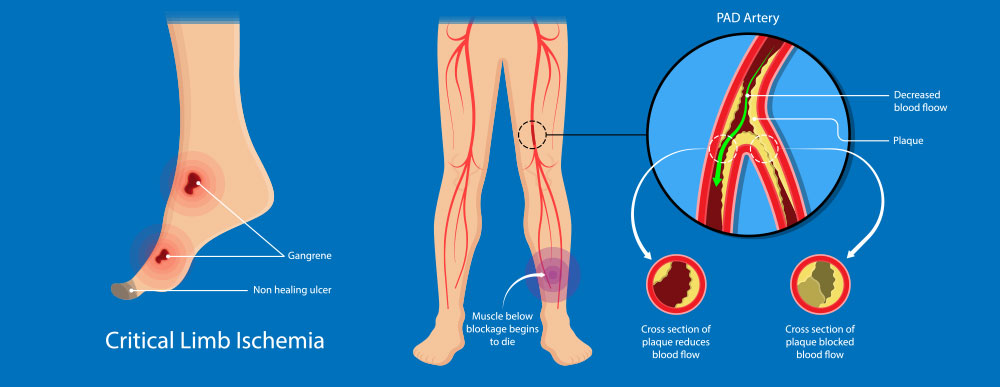Office Hours
- Mon-Fri 9:00a – 5:00p
Saturday Appt. Only
Sunday Closed
Contact Info
- Phone: 1-323-264-6157
Ask Us a Question
Peripheral Arterial Disease

What Is PAD?
PAD is short for Peripheral Arterial Disease. PAD is caused by a blockage or narrowing of the arteries in the legs when fatty deposits called plaque buildup. The buildup of plaque causes the arteries to harden and narrow, which is called atherosclerosis. This results in a reduction of blood flow to the legs and feet. This is commonly referred to as poor circulation.
PAD occurs most often in the arteries in the legs, but it can also affect other arteries that carry blood outside the heart. This includes arteries that go to the aorta, the brain, the arms, the kidneys, and the stomach. When arteries inside the heart are hardened or narrowed, it is called coronary artery disease or cardiovascular disease.
PAD affects 8 to 12 million Americans, and one in every five people over the age of 70 has the disease. People with PAD have a two-to-six times’ greater chance of death from a heart attack or stroke. PAD and diabetes are the leading causes of foot or leg amputations in the United States.
Causes/Risk Factors
Risk factors for PAD and other conditions that may complicate PAD include the following:
- Smoking
- High Cholesterol
- High Blood Pressure
- Physical inactivity
- Obesity
- Diabetes
Symptoms
The symptoms of PAD include the following:
- Fatigue, tiredness, or pain in your legs, thighs, or buttocks that always happens when you walk but goes away when you rest.
- Foot or toe pain at rest that often disturbs your sleep.
- Skin wounds or ulcers on your feet or toes that are slow to heal (or that do not heal for 8 to 12 weeks)
However, many individuals with PAD do not experience typical leg symptoms such as cramping, pain, or fatigue known as claudication.
When to Visit a Podiatrist
Do not ignore leg pain. It is important to discuss any leg or thigh pain that you are having with your podiatric physician since it could be a warning sign of a serious disease such as PAD. Early detection of PAD can offer an opportunity to treat risk factors that can slow the progression of the disease and decrease the chance of heart attack and stroke.
Diagnosis and Treatment
Your podiatric physician can do a simple test to determine if you have PAD. The test is called an ABI, or ankle-brachial index. It compares the blood pressure in your ankles with the blood pressure in your arm. If your ABI is abnormal, your podiatric physician may order other tests to determine the extent of your PAD.
PAD can be treated with lifestyle changes, medicines, and surgical procedures if necessary. Medical treatment options include:
- Programs to stop smoking
- Blood pressure control
- Lowering cholesterol
- Manage high blood sugar (diabetes)
- Medications to prevent clotting
- Healthy diet
- Exercise program
A variety of surgical treatment options are available depending on the location and severity of the artery blockage. Your podiatric physician can refer you to the appropriate specialist for these procedures.
